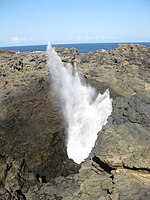Kiama Blowhole
The Kiama Blowhole is a blowhole in the town of Kiama, New South Wales, Australia. It is one of the town's major tourist attraction. Under certain sea conditions, the blowhole can spray water up to 25 metres (82 ft) in the air, in quantities that thoroughly drench any bystanders. There is a second, less famous blowhole in Kiama, commonly referred to as the "Little Blowhole" by locals. It is much smaller than the other (called the "Big Blowhole"), but due to its narrow shape, it is more reliable than the Big Blowhole, and in the right conditions can be equally spectacular.
The blowhole attracts 900,000 tourists a year.[1] Kiama Blowhole is just a few metres beyond the coastline. The "little blowhole" is located at the Little Blowhole Reserve, Tingira Crescent, Kiama, 2km south of the main blowhole.
History
The blowhole was formed from basalt lava flows approximately 260 million years ago[2] and was first discovered by local Aboriginals who named it 'Khanterinte'. The blowhole was first written about by George Bass on 6 December 1797. Bass had captained a crew of six and set out on an open whaleboat to explore the south coast of Australia. He noticed the blowhole after anchoring his boat in a sheltered bay.
Gallery
- The Kiama Blowholes
-
Kiama blowhole panorama
-
Kiama blowhole panoramic view, NSW
-
Kiama blowhole, NSW
-
Kiama Blowhole in action -
Kiama Blowhole sea cave entrance -
Kiama Blowhole site -
The Little Blowhole in action
References
- ^ "Kiama Blowhole". Retrieved 2018-09-01.
- ^ "Blowholes". Blowholes. Retrieved 2018-09-01.
External links
34°40′18.5″S 150°51′47″E / 34.671806°S 150.86306°E







